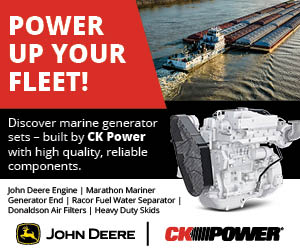The subject of this column in the January 22, 2024, issue of The Waterways Journal was the twin-screw, diesel towboat Progress of the American Barge Line (ABL) which was built in 1939. This week’s column will look at the sister vessel, which was built concurrently with the Progress, but came out slightly after it.
ABL formed a shipyard in 1938 at Jeffersonville, Ind., on property that had once been the Sweeney Brothers shipyard. The name of the new yard was Jeffersonville Boat & Machine Company, but by 1939 it was not yet building complete vessels.
The contract to build the hulls of the two new ABL boats was given to the Treadwell on April 10 to Jeffersonville, where it would be completed by Jeffersonville Boat & Machine Company. The second hull was launched on April 23 and was nearing completion, to include deck fittings and towknees.
J. Mack Gamble’s Upper Ohio News column in the May 6, 1939, WJ noted that the second hull had gone down past his house at Clarington, Ohio, on April 26 in tow of the ABL steamer American. The Louisville news column by Charles W. Stoll in the June 24, 1939, WJ said the first boat was nearing completion, and the second was in the “earlier stages of superstructure construction.” Stoll also commented that the two boats would look very similar to the Tom Sawyer and Franklin D. Roosevelt of the Federal Barge Line, both built by Treadwell in 1933.
The second boat was named Patriot and was identical to the Progress. The steel hull was 160 by 40, and it was powered by two Cooper-Bessemer LT-8 diesels with 15 ½-inch bore, 22-inch stroke, each rated at 1,000 hp. at 300 rpm. There were four rudders, two for steering and two for flanking, and the four-blade props were of cast steel, 84 inches in diameter with 52 inches pitch. There were two “waste heat” boilers that were heated by engine exhaust to power a 40 kw. steam turbine electric generator as well as the two steam-driven Shoellhorn-Albrecht capstans and even a steam whistle. There was also a 50 kw. National Superior diesel generator.
The superstructure consisted of a full-length main cabin and a shorter cabin on the second deck surmounted by a raised pilothouse with angled front corners. Two tall, stately smokestacks rose from an engineroom skylight aft of the upper cabin, with the steam whistle mounted to the port stack. Two Carlisle & Finch carbon-arc searchlights were mounted atop the pilothouse, and a large boom was mounted at the after end of the main cabin to handle the yawl.
The late Robert L. Gray, who has been mentioned in these columns several times, was from Louisville and attended the J.B Speed School of Engineering. He related to this writer that he interned at Jeffersonville Boat & Machine, helped in placing the machinery in the Progress and Patriot and worked in the enginerooms of the boats on their first trips. After graduation in 1941, he went to work for Ashland Oil & Refining Company, which was engaged in building a fleet of diesel vessels. He brought radar to the rivers in 1946, and for this and other accomplishments, he was a National Rivers Hall of Fame Achievement Award Honoree in 1990.
The new Patriot entered service in the fall of 1939. It was frequently mentioned in the Ohio River news columns of The Waterways Journal. On February 22, 1942, the Patriot, with Capt. Frank Phipps as master, was tied off above the Cincinnati bridges in poor visibility. The steamer G.W. McBride of the Ohio River Company was double tripping a tow down through the bridges and struck a pier of the L&N bridge, breaking in two and sinking. Sixteen crew members were lost, and five were rescued. The Patriot and Union Barge Line’s Peace conducted the recovery of the tow.

In May 1952, the Patriot was sold to O.F. Shearer & Sons, Cincinnati, which renamed it O.F. Shearer in 1953. An earlier steam sternwheel boat of the same name had been dismantled in 1951. Pilots who worked on the diesel O.F. Shearer have mentioned that it was a notoriously poor handler and did not answer the flanking rudders well. An ad for the Marietta Manufacturing Company, Point Pleasant, W.Va., which appeared in the April 25, 1959, issue of the WJ, featured a photo of the boat on drydock with the stern missing. The ad stated that the old stern was removed and replaced with one that was 10 feet shorter. Work included new shafts, rudders, kort nozzles and newly designed propellers.
This writer had not heard of this before and would be curious if this extensive work caused an improvement. Perhaps some former Shearer pilots or marine architect Ed Shearer can shed some light on this. The Shearer interests were sold in 1973 to Indiana & Michigan Electric Company (AEP), and the O.F. Shearer was utilized as a spare boat and training platform for new hires at the Lakin, W.Va., landing. In January 1979, it was sold to Boeuf River Inc., Wisner, La., and renamed Angel Patience.
According to the late Dan Owen, Boeuf River was headed by a man named Carl Batey who intended to operate the boat on the Ouachita River. On the delivery trip from Lakin (above Point Pleasant) to Louisiana, it suffered several breakdowns and was ultimately turned into a floating restaurant. At one point, ungainly fake sidewheels were placed on it. The vessel ultimately wound up at Little Rock, Ark., as a restaurant and again was identified as the Patriot. Ed Shearer sought it out about 2006 and took many photos showing the upper works and interior to be in decent shape. However, the hull deteriorated, and the vessel was ultimately scrapped about 2016.
Featured image caption: The new Patriot in 1939. (Photo from the author’s collection)




